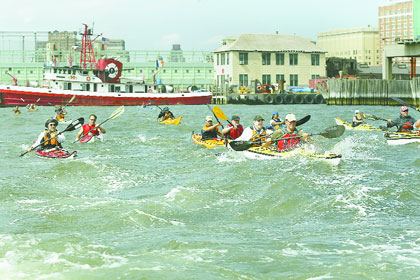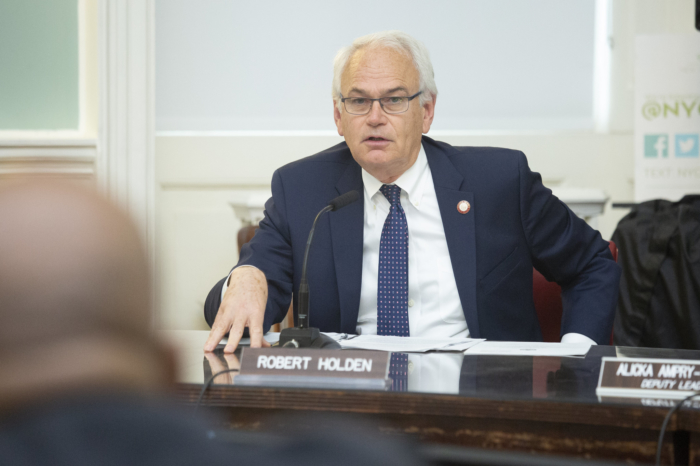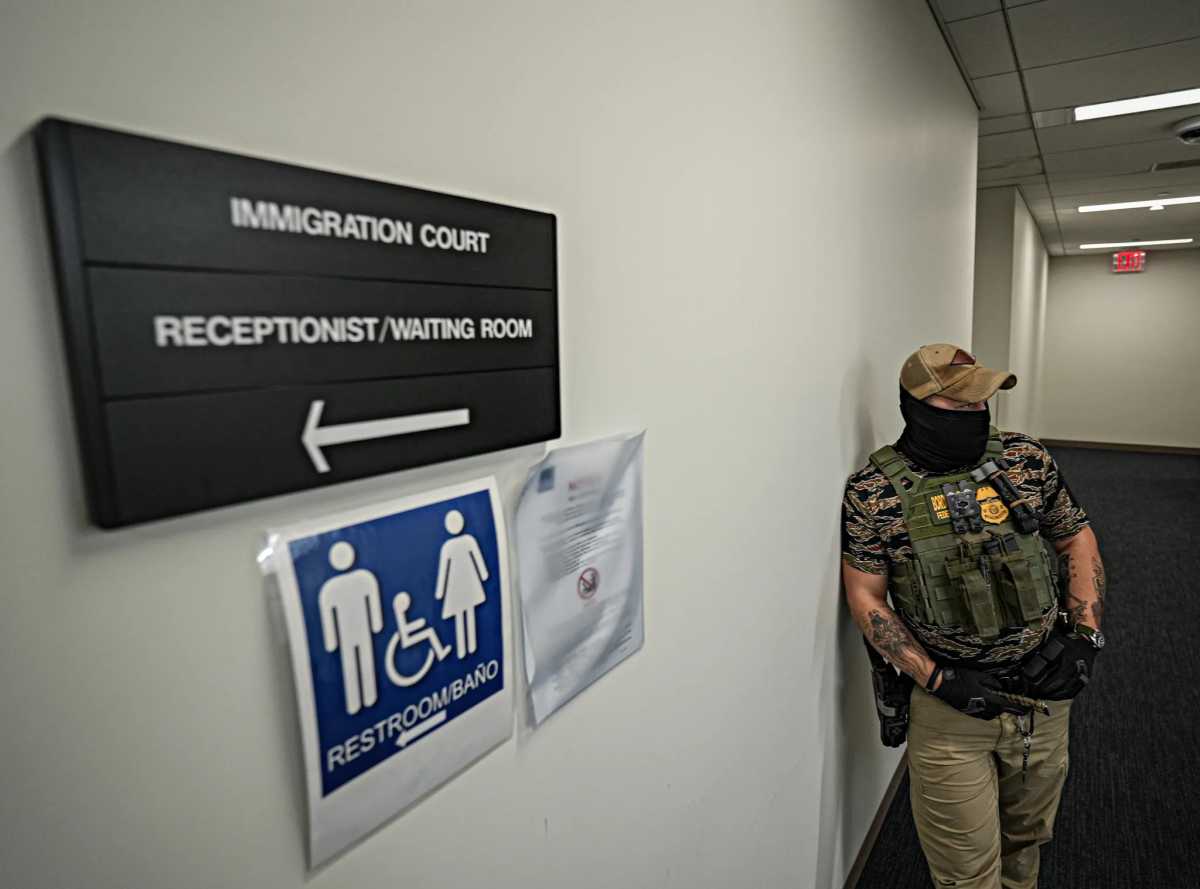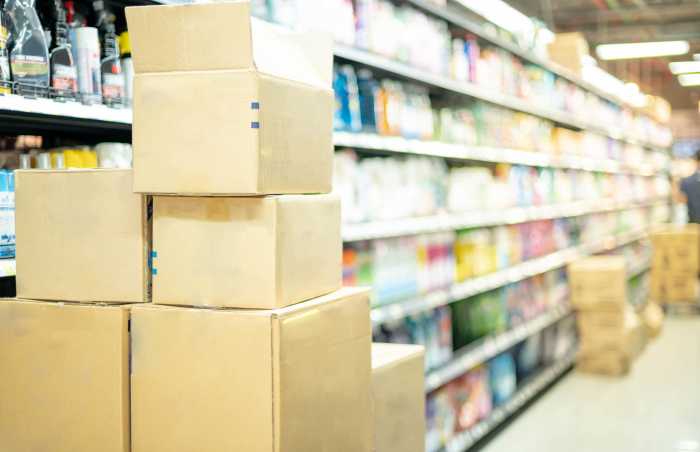By Josh Rogers
Governor West St. may not get tunnel, Pataki says after kayak outing
When told that Madelyn Wils — C.B. 1’s chairperson and a Pataki appointee to the L.M.D.C. board – said the tunnel money would be better spent on the rail link, the governor said he would consider any suggestions.
“We always listen to the community and alternative ideas,” Pataki said July 15 as he was drying off on Tribeca’s Pier 26. As to whether he was now open to the no-tunnel option, Pataki said he will let the development corporation decide what’s best for the W.T.C. site.
“This is going to be decided by the L.M.D.C.,” the governor said about the agency he created at the end of 2001. “I believe in putting people in place with enormous integrity and letting them make the decision.”
Hudson River Park and rail link
Pataki answered questions about Lower Manhattan after participating in the fourth annual Great Hudson River Paddle, a 10-day, 146-mile journey from Albany to Tribeca. Pataki has paddled in different areas and this year joined in for the last leg from Chelsea Piers to Pier 26 – both in the Hudson River Park.
The governor pledged that the whole park would be built and said the L.M.D.C. would make a “significant contribution” to building the Lower Manhattan section. The Hudson River Park Trust, a state-city agency, has applied to the L.M.D.C. for $70 million for the park.
Connie Fishman, the Trust’s president, said it would still be an uphill battle to build the rest of the park even with Pataki’s endorsement. “He and his support have never been the problem,” she said. “It’s always been more complicated than one person’s support for one project.”
Fishman said there are a lot of competing priorities for the remaining L.M.D.C. money and other funds. About $900 million is left in the L.M.D.C. budget, which is funded out of federal, post-9/11 federal community development block grants of $2.8 billion.
At the July 14 C.B. 1 meeting, Wils said: “I’m concerned about the L.M.D.C. money — with how much money is left and what else can be done with that.”
The rail link connecting Lower Manhattan to the Long Island Rail Road and J.F.K. Airport would cost $6 billion and officials are hoping for additional federal funds to help pay for it. The community board’s executive committee approved the outlines of a resolution Wednesday which calls on taking the nearly $700 million that could be saved by not building the tunnel and shifting it to the rail link. Many C.B. 1 members and Downtown business leaders favor the link as one of the best ways to ensure Downtown’s economic future.
Pataki, said Thursday that the corporation has already agreed to spend $200 million on the project, although his spokesperson later said the governor had misspoken.
“The L.M.D.C. has already committed, I think, in excess of $200 million to the rail link,” Pataki told Downtown Express.
Pataki had previously called on the L.M.D.C. to help pay for the rail link, but Thursday was the first time he had mentioned a specific dollar amount. A few months ago, Sen. Chuck Schumer, another rail link supporter, said Pataki had told him privately that the L.M.D.C.’s remaining $1 billion or so would be set aside for the link.
A few hours after Pataki’s comments, Lynn Rasic, his spokesperson, called to retract the rail comment. “The governor misspoke about the $200 million for the rail link,” she said. “He has talked about significant funds, but a figure hasn’t been decided upon.”
West St. options
The state Dept. of Transportation is currently studying three options for West St. between Vesey and Liberty Sts.: the $860 million tunnel with four tunnel lanes and four at street level; $175 million in at-grade pedestrian improvements with eight lanes; repairing the temporary roadway to existing conditions with six lanes of traffic at a cost of $135 million.
The intent of the tunnel is to make it safer to cross the highway and to provide a more appropriate setting for the proposed $350 million W.T.C. memorial, which will be funded in part by the L.M.D.C.
Tim Carey, pre-sident and C.E.O. of the Battery Park City Authority, said he remains convinced the tunnel is the best and safest solution. “We just believe it is better for access for residents, commercial tenants and for the memorial,” Carey said in a telephone interview. “Public safety is my number one issue.”
Members of the C.B. 1 executive committee disagreed as to whether the tunnel would be beneficial, but even those who saw benefits, said it was not worth nearly a billion dollars given all of the other priorities. The committe voted for the $175 million at-grade option.
Anthony Notaro, chairperson of the board’s Battery Park City committee, said the tunnel would not encourage economic development or attract people to Lower Manhattan, which should be the goal of the transportation investments. He said the tunnel would be of little help to residents because it would be near the neighborhood’s offices, not the apartment buildings.
“You’re talking about an awfully big project that doesn’t benefit anyone north of Vesey or south of Albany [St.],” he said.
Wils, as an L.M.D.C. board member, has had regular discussions with the officials studying the tunnel question. She said it is becoming clearer to her that it would be an improvement that would relieve traffic on other streets such as Church. She added the tunnel would make it easier to find room for a tour bus drop-off area near the W.T.C. and to place the delivery truck entry ramps for the W.T.C. offices. But even with those benefits, Wils said the rail link is much more important. She said if the tunnel money were committed in the next few months, the L.M.D.C. would likely have to spend a lot on the rail link, leaving little money for the other community priorities.
C.B. 1 has previously passed a resolution asking the L.M.D.C. to spend the remaining money on a list of projects including East and Hudson River Park improvements, a new school, a recreation center and affordable housing.
Bill Love, vice chairperson of the Save West Street Coalition, a group formed to stop the tunnel, said after the C.B. 1 committee meeting that he was happy to witness the board’s most definitive action.
“I’m beginning to get optimistic that we may be able to get D.O.T. and the governor not to build this thing,” Love said.
WWW Downtown Express
Also Read: https://www.amny.com/news/young-guns-running-the-citys-tv-network/


































